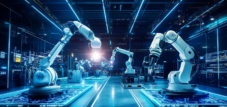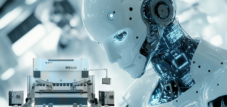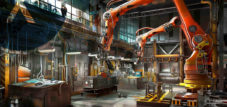Published on: April 4, 2025 / update from: April 4, 2025 - Author: Konrad Wolfenstein
In this way, industries benefit from overhauled robots
Used robot: The smart choice for automation
In recent years, the use of used robots has developed into a strategic solution for numerous industries that want to combine cost efficiency with technological reliability. In particular, industries with high automation needs, limited budgets or specific requirements for proven technologies find an attractive alternative to new acquisitions in general overhauled industrial robots. The following sections analyze in detail which branches of industry benefit most from this development and how to use the advantages of used robots.
Suitable for:
Automotive industry: pioneer and main user of used robots
The automotive industry is considered a pioneer in the introduction of robotics and still dominates the market for used industrial robots. Many of the available models originally come from assembly plants of large automobile manufacturers, where they took on tasks such as welding, painting or body assembly. After an average service life of five to seven years, these robots have returned to the market via specialized retailers such as Eurobots or Surplex, often overhauled and equipped with modernized control systems.
Welding and painting applications
Used KUKA and ABB robots from automotive production are particularly suitable for repetitive high-precision tasks. A KR 210 from Kuka, originally used in the body montage, can be easily reused in the series production of vehicle components after an overhaul. These models offer a load of up to 300 kg and a repeat accuracy of ± 0.05 mm, which makes it ideal for demanding welding processes.
Cost savings in the supply chain
Suppliers to the automotive industry, often medium -sized, use used robots to adapt to volatile order situations. A general overhauled Fanuc M-710IC, which now costs over 100,000 euros, is used from 45,000 euros-a saving of more than 50%. This price structure enables minor companies to build flexible production cells without entering into long -term financing risks.
Small and medium -sized companies (SME): democratization of automation
For SMEs, used robots often represent the entry into automation. According to the International Federation of Robotics (IFR), 38% of German medium -sized robot systems already used used robot systems in 2024 compared to 22% in 2020. This development is accelerated by platforms such as Surplex.com, which carry out auctions every month without minimum bids and thus simplify market access.
Flexibility through modular systems
SMEs benefit from the versatility of used models such as the ABB IRB 4600, which can be converted for both palletry and machine loading. By avoiding industry -specific special designs, companies reduce implementation costs by an average of 30%. A mechanical engineering company from Baden-Württemberg reports, for example, that a used KUKA KR 16 could be integrated into the existing CNC processing line in just six weeks.
Amortization and financing models
The shorter amortization time of used robots - often under two years - makes it particularly attractive for SMEs. Leasing offers with monthly installments from 800 euros even enable handicrafts to access automation technology. In addition, providers such as Usedrobottrade offer six -month guarantees to minimize technical risks.
Suitable for:
- The AI-controlled robotics and humanoid robots: hype or reality? A critical analysis of the market maturity
General production industry: wide fields of application
In the metal processing industry, in tool construction and in plastic processing, used robots are used primarily for material handling and quality control. A Fanuc M-20ia, originally used in the automotive industry, takes over the deburring of aluminum parts with a cycle time of 12 seconds per part-an increase of 40% compared to manual processing in a metal foundry.
Palletizing and packaging
Used palletry robots such as the Yaskawa Motoman EPX2900 are increasingly found in food and pharmaceutical operations. With a range of 2,900 mm and a load of 250 kg, you automate the stacking of boxes on Euro pallets, with completing an average of 1,200 units per hour. The integration into existing lines is simplified by standardized interfaces such as Profinet or Ethernet/IP.
Welding automation in series production
Medium -sized mechanical engineers use used welding robots to keep small series profitable. An ABB IRB 1520ID with integrated wire feed device reduces the welding costs per meter by up to 25% compared to manual processes. By using offline programming (OLP), the changeover time between different weld tasks is shortened to under four hours.
Logistics and intralogistics: automation of the flow of goods
The logistics industry uses used robots in particular for picking and container loading. A KUKA KR 1000 Titan, used from 75,000 euros, can stack pallets of up to 1,000 kg of weight and thus reduce personnel use in high -beam bearings by two layers a day.
Mobile robotic solutions
General-overhauled driverless transport systems (FTS) based on used Omron LD-250 platforms enable the automation of material transports in production halls. These systems navigate using SLAM technology (simultaneous localization and mapping) and can be combined with used kink robots into hybrid solutions.
E-commerce adaptation
Online retailers are increasingly relying on used pick-and-place robots to intercept lace loads in package picking. A Fanuc LR-10IA with 3D-vision system processes up to 800 items per hour and reduces false picks by machine learning algorithms to less than 0.3%.
Electronics and semiconductor industry: precision at reduced costs
In microelectronic production, used scara robots enable the precise installation of circuit boards. An Epson T3-401S, used from 15,000 euros, positions SMD components with a repeat accuracy of ± 0.01 mm and reaches cycle times below 0.3 seconds per component.
Models that are suitable for clean room
Overhauled robots of the Fanuc M-1ia series are subsequently equipped with low-particle lubricants and special surface coatings in order to meet ISO class 5 clean room conditions. This reduces the investment costs for semiconductor manufacturers by up to 60% compared to new purchases.
Education and research: practical training
Technical universities and vocational training centers use used industrial robots to offer practical training. An ABB IRB 120 training cell including programming station is already available from 12,000 euros and simulates real production scenarios.
Research projects and prototyping
Universities use used robot platforms such as the KUKA YouUBot to test algorithms for collaborative robotics at low cost. Open source control frameworks such as ROS (Robot Operating System) create innovative applications for human-robot interaction.
Sustainability as a cross -industry driver
Regardless of the specific industry, the sustainability aspect plays a central role. According to studies by the Fraunhofer IPA, the reuse of a typical 200 kg industrial robot saves around 8.5 tons of CO₂ equivalents-this corresponds to the annual climate performance of 380. Companies like Surplex document this balance sheet by Environmental Product Declarations (EPDS), which further drives the circular economy in industry.
Wide adoption through technological maturity
The analyzed industries demonstrate that used robots have long no longer been compromise, but offer a strategic advantage. With general overhaul processes, which reach 85% of the new device performance at 40-60% of the costs, you establish yourself as an equal pillar of industrial automation. The progressive standardization of interfaces and the availability of spare parts bearings will further accelerate this development in the coming years.
Suitable for:
Your global marketing and business development partner
☑️ Our business language is English or German
☑️ NEW: Correspondence in your national language!
I would be happy to serve you and my team as a personal advisor.
You can contact me by filling out the contact form or simply call me on +49 89 89 674 804 (Munich) . My email address is: wolfenstein ∂ xpert.digital
I'm looking forward to our joint project.














